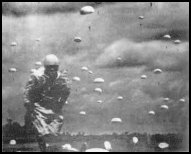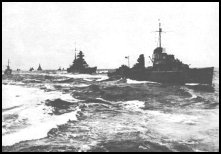 Japanese paratroops land at Palembang in Sumatra |
Project 60: A Day-by-Day Diary of WWII
Remembering the First Fight Against Fascism |
 British destroyers head out to meet the German squadron in "The Channel Dash" |
 Japanese paratroops land at Palembang in Sumatra |
Project 60: A Day-by-Day Diary of WWII
Remembering the First Fight Against Fascism |
 British destroyers head out to meet the German squadron in "The Channel Dash" |
February 10,
1942 The 82,423 ton
ocean liner Normandie, burned and partially capsized in New York
harbor. Propagandists in Berlin attempted to claim they had sabotaged the
ship, but investigations showed that a careless dockworker caused the
fire. February 11, 1942 At 2300, the battle cruisers Scharnhorst, Gneisenau and the light cruiser Prinz Eugen, leave the port of Brest and, in a daring move into the English Channel, head for Keil.
French-Canadians riot in the streets of Montreal, protesting against the proposed draft by the government. Over a thousand demonstrators battled with local police.
Australia called up all able bodied men up to 35 years and unmarried men up to 40 years for national service. “The Channel
Dash” - Low clouds and rain
shroud the German battle cruisers Scharnhorst, Gneisenau and the
light cruiser Prinz Eugen, as they move northeast through the
English Channel. Because of the bad weather, British aerial patrols did
not spot the group until 1100 when a Spitfire from Fighter Command spotted
the squadron of Le Touquet, as they entered the Straits of Dover. All
available air and naval assets were mobilized to strike at the German
ships. The first response came from British Motor Torpedo Boats (MTBs)
which attacked at 1200. Due to the heavy defensive firepower of the German
ships, the MTBs were forced to engage from extreme range and missed. At
1300, six British Swordfish Torpedo planes (a venerable biplane
affectionately called the “Stringbag”) attacked the ships. Five of the
planes were shot down and no torpedoes hit the Germans. By 1430, the
Germans were being engaged nearly continuously. Destroyers from Harwich
and aircraft from Coastal Command engaged the German ships. Even Bomber
Commands heavy strategic bombers flew 242 sorties against the enemy before
darkness came. All of these attacks came to naught. In the end, the only
damage came when Gneisenau hit a mine at 2035 and Scharnhosrt
did the same at 2055. Japanese forces
capture Bandjermasin, capital of Borneo and Macassar, capital of Celebes. February 13, 1942 Advancing
Soviet units cross into Belorusssa as the Winter Offensive continues.
German resistance is stiffening and advances are limited. The “Channel
Dash” ends as Scharnhorst puts into Wilhelmshaven and Gneisenau
and Prinz Eugen put in at Kiel in the early morning darkness. 
February 14, 1942 Japanese paratroops land at Palembang, opening the invasion of Sumatra. Singapore surrenders to the
Japanese. 16,000 British, 14,000 Australian, and 32,000 Indian troops were
surrendered after taking 9,000 casualties. The Japanese also lost 9,000
killed and wounded in the campaign. Most of those captured would end up
working on the notorious Burma-Thai Railway (remember “Bridge over the
River Kwai”?) where half would die before the end of the war. German
submarines, using their deck cannons, bombard the Dutch oil storage tanks
and refineries on Aruba and Curacao in the Caribbean. Those wishing to contribute items. stories or comments should contact D.A. Friedrichs |
Editor's Corner The items found in this section are comments from the editors of Project 60 and may not necessarily reflect the opinions of bartcop. Vietnam
and Afghanistan When the
“war against terrorism” began, many knowledgeable people warned that
our operations in Afghanistan would turn into another Vietnam. In the
flush of “victory”, much of the gloomy projections have been
relegated to the trash heap. However,
there are still some interesting comparisons that can be made. In the early
days of Vietnam, the United States inserted teams of Special Forces, to
assist in establishing good relations with the locals by helping with
village defense, health, and education programs. These operations were
highly successful in combating the influence of the Viet Cong. In the
Afghan war, a similar, and, like its predecessor, highly successful
program is well underway. Like Vietnam,
we are currently destroying any good will we have with the locals by
blowing stuff up. The old saying “we had to destroy the village in
order to save it” is alive and well and making a comeback in
Afghanistan. However, we have progressed a long way in 35 years. In
Vietnam, we would send an infantry platoon with Zippos into a village
and burn it down. In Afghanistan, the mud doesn’t burn, so we use
precision-guided ordnance to turn peoples homes into craters. The
downside of this “improved” system, is that by the time we get
around to blowing up a house, a wedding party moves in and we blow up a
few score party-goers like we did at Qalaye Niazi. The
biggest similarity between the two wars is the Pentagon briefings. The
goals and objectives are different but the level of lies and deceits
have not changed one bit. In Vietnam, the goal was to show progress by
inflating “body counts”. In our new, more compassionate world, we
measure progress by how many buildings we blow up in a sterile and
non-violent manner, with “minimal collateral damage”.
In Vietnam villages were called Viet Cong strongholds and in
Afghanistan they are called Al Qaeda compounds. In reality, these are
places which were filled with people, who wanted nothing more to try to scratch out
a life for themselves before we came and destroyed everything in their
pitiful lives. The one area
that is glaringly different is how the US press is conducting operations in
the two wars. In Vietnam, the horrors and violence of war were brought
home. We saw that people, our soldiers, their soldiers, innocent people,
were horribly maimed and killed in war. Since Desert Storm, war for our
citizens has been converted into some sort of sick bloodless video game.
Our press today call sitting in a pentagon briefing journalism and don’t bother
to fact check the lies they are fed by the Administration. The India
Times has better, more accurate and more complete war coverage than the
New York Times. This is a sad and pathetic commentary on the health of
our Fourth Estate. Like Vietnam,
one of the reasons we got involved in the first place was to prop up a
corrupt and inept government, which we installed. In Afghanistan, we
have installed a government, but it remains to be seen just how corrupt
and inept it will be. Early signs, despite what is reported in the US
media, are not particularly encouraging. In Vietnam,
the primary reason for our presence was to stop Communism. In
Afghanistan, we have traded the bogyman of Communism for terrorism. Both
were and are vile and, if you will, evil. However, neither will be
defeated by military intervention. Economic stability, justice and
self-determination are the keys to defeating both of those enemies. In both
Vietnam and Afghanistan, the more compelling, and less acknowledged,
reason for intervention appears to be US business interests. In the
60’s it was rubber and oil. Now it’s just oil and not even really
oil, just a place to put a pipeline that the Ruskies don’t control.
We seem to have an annoying habit of trading red blood for black gold. Previous Columns Want to Win - Think Before You Lash Out - "If we are serious about taking the war to the enemy, it is time to look ..." The First Fight Against Fascism - We must remember the Spanish Civil War also. Arguing Victory - "... Each nation who fought against fascist tyranny in WWII brought with it part of whole needed to defeat that evil..." War, Glory, Honor and Remembrance - "War is a brutal and savage insult on human society..." The
First Casualty... in time of war, those in power are even more inclined to hide the truth,
since that truth is often manifest in the most gruesome and terrible
acts. |